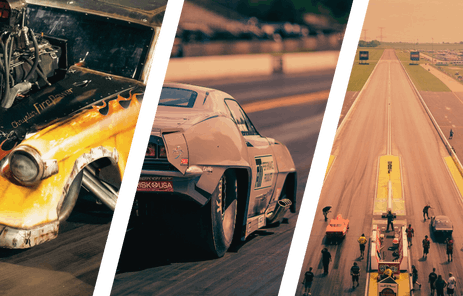Success doesn’t come without sacrifice, and many of auto racing’s all-time greats were those that were willing to operate with obsession, continually taking risks, experimenting, and putting in the round-the-clock tireless efforts that others perhaps were unwilling to match.

In recent years, Ryan Mitchell has established himself as one of no-prep drag racing’s most accomplished and feared competitors, and a major component of his success has been a relentless drive to search for new and better ways to optimize his program. He’s campaigned a number of different engine and power adder combinations in recent seasons, and in the first three and a half months of 2025 alone, he’s changed engines and swapped power adder configurations nearly as often as he’s changed his clothes. The work, he says, has been worth it.
Mitchell’s latest experiment is a compressed air supercharging (CAS) system on his KC Maxx Pontiac Firebird, a technology — one notably popularized by Mickey Thompson in the early 1970s — that many racers have overlooked until recently. “We had seen Mark Griffin run it five or six years ago,” Ryan says. “I didn’t give it much weight. It’s neat and all, but I didn’t see the point.” But looking at the upsides to the system led him back to the concept. By January 2025, a system was on the car, and he was off and running.

After a win with his supercharger setup in Abilene, Texas early this year, Mitchell came home, made the swap, and raced at three events across the east coast, putting the CAS system through its paces. “We went to three races in one week, and we loved it,” he said. Unlike turbos and superchargers, the CAS system uses high-pressure bottled air (pressurized to about 3,300 psi) regulated into the engine, delivering instant boost without any parasitic loss. It’s clean, simple, and tunable. “I feel that it provides really great motor longevity, a huge safety tuning window, and no parasitic drag on the engine,” he adds. The CAS system utilizes bottle-mounted gate valves, a high-pressure mechanical regulator, medium pressure lines and fittings, an electronic pressure regulator, and a medium pressure ejector that contains the mechanical butterfly isolation valve.

Mitchell put the system to work on both his 540-inch big-block and a newly-built 427-inch LS, cycling between combinations several times to gather data.
“We just had to keep changing things up, and try something different,” he says. And tried it, he has. “In just the last few weeks, we did twin-turbo big-block, then supercharged big-block, then compressed air big-block, for a week. Then we went LS for about three weeks, and then went back to compressed air big-block, and then compressed air LS again this week. We’re just trying to learn on everything. I feel the CAS system provides really great motor longevity, a huge safety tuning window, and no parasitic losses.”

Airflow and pressure are layered through the series of regulators and medium and high pressure lines that determines how much charge the motor sees and when. This gives Mitchell the ability to stage the car naturally aspirated, build light manifold pressure on the transbrake, then fully switch to compressed air before launch. The transition is seamless and rapid. “We jump from like 600 horsepower up to 850 or 900 as we’re staging, and then as soon as we leave, it jumps to 2,000-plus,” he explains.
“We tune it just like you would on like a normal centrifugal supercharger or turbo application — you’re still using your multi-bar fuel map, so we’ll be running a five-bar MAP sensor, and all of our tunes are dialed in for naturally aspirated, as we’re not making boost. Then, as soon as it starts to transition to positive manifold pressure, it just targets the correct timing and air/fuel ratio for the positive manifold pressure.

“As the temperatures drop, we have a couple of modifiers we built into the tune to help compensate,” he adds. Mitchell says early on-track testing indicates similar performance at 18 psi that other forms of power-adding might range from 32 to 44 psi.
Claims from the compressed air camp say that there are gains to be had from the intake air temperatures. Typical boosted applications can show higher charge temperatures without intercooling, although the addition of alcohol post-compressor lowers these numbers dramatically. “We’re typically about 40 degrees Fahrenheit going through the traps,” Ryan said. Whether that amounts to much factoring in all of the other air-charge variables is to be determined.
Mitchell claims that consistency, long a hallmark of blower combinations, hasn’t been lost. He says the CAS system has matched, or in some cases exceeded, Mitchell’s previous elapsed times and speeds at familiar tracks and surfaces. “It’s smooth, clean power, and we’re seeing the same consistency,” he said. Refill time is quick, and the system is simple enough to fill the two bottles between rounds using a cascade system and trailer-mounted compressor.

There are some fierce debates going on about how viable – and reliable, these systems are going to be. That being said, so far, Mitchell estimates about 60 combined dyno and track passes with the compressed air supercharging system. Minor adjustments, like adding a third bottle for capacity on longer runs, are being planned.
As the first heads-up no-prep racer to field the CAS system in competition, Mitchell is at the front of the innovation curve. It will be interesting to see whether he’s able to stay in the winner’s circle with this new combo.
You might also like
History Restored Bob Riffle's 1973 Dodge Dart
Bob Riffle's 1973 Dodge Dart was an iconic race car in the 1970s. The Dart recently was fully restored to its original state.


